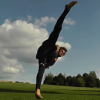Modeling for any game environment?
I'll try to keep away from the usual two-thousand page essays that my posts always turn into...
I had trouble figuring out how to title this topic. Basically, I've been designing a game for more than half a year now. Recently I decided upon a graphics overhaul. It went from 16-bit spriting to cel-shaded 3D models in a 2D play environment, where the camera can move slightly in the 3D plane for dynamic effect. Even though I've been a pixel artist for a decade-plus, I believe, as a one-man team, this will save me years down the road...if I set things up correctly now. I learned Blender in a week and that went...way better than I thought it would, and I have two basemeshes for characters. Here's where I'm stuck.
I want to start texturing and rigging my meshes, but there are many elements that I cannot find existing documentation about how to proceed on. I want all characters' clothing and hair to react on their own to gravity and wind. My game style is cartoony; Super Smash Bros. Melee does the effect simply enough, and I would be happy to emulate something like that. But this halts me from rigging right now, because I don't know what the process would entail -- especially if I want those built-in physics (inaccurate phrase?) to translate to any game engine, including one built from scratch. Are softbodies the answer? But then, how would that data transfer to different engines? Is that even possible? I am floundering completely on finding help on my own, probably because I'm so new to modeling and wouldn't know the solution if I found it. Which is where you guys come in -- might I ask of your guys's knowledge on animating models in Blender with elements that will react to game environments? Am I sorely misguided? I want to have models animated ASAP so I can use them to create fitting backgrounds and start mocking out levels and game situations (and simply to have those assets done). But I fear going back and spending weeks, or months, undoing work once it's time for those models to go into an engine, when deadlines are more of a factor. Maybe this is just a part of the craft -- if that's the case, I'll bite the bullet when the time comes. Also, the story necessitates the models be separate from costumes so they can wear different outfits, which might render me unable to view complete models until I have them in an engine(?) I just need to be pointed in the right direction right now, because I'm flying blind.
Wall of text, as usual. Any insight is deeply appreciated. I could upload model screenshots if it becomes relevant to giving me information, but I wasn't sure if it was at this point. Thanks!
especially if I want those built-in physics (inaccurate phrase?) to translate to any game engine, including one built from scratch. Are softbodies the answer? But then, how would that data transfer to different engines?
There is two ways to do this, one you use soft bodies as you pointed out. This is done by applying physics to the vertices of each mesh; normally with a shader. You could also use the tools provided by Nvidia for this.
I think this isn't what you are looking for.
The second way is to use bones, bones with a attached physics object.
In lots of anime styled games -cell shaded- uses this. It's also used in Diablo and many other RPG games because it is fast. Most engines will support it as it's used for rag dolls.
MikuMikuDance is a good reference, it is how they animate the hair and clothing.
It's just basic ragdoll stuff.
Which is where you guys come in -- might I ask of your guys's knowledge on animating models in Blender with elements that will react to game environments?
You are somewhat misguided, physics like this is done in the engine; not the 3D tool.
ANY real time thing, from IK bones, physics, animated materials, particles all of the things that happen in the game is made in the engine; not the 3D tool.
Even bone animations is done 60% in the engine and only the bases is made in the 3D tool.
The rule is simple, if the player can effect it, the effect was made in a game engine.
But I fear going back and spending weeks, or months, undoing work once it's time for those models to go into an engine, when deadlines are more of a factor.
This is part of modeling. A single change by a developer could undo weeks of work, force modelers to re-import over a hundred models, all with only a small change to them.
It's part of making games, there is no done 3D model until the game is released even then there is often need for changing models. Never fool yourself into thinking you can delete a models files..
My advice is to keep backup files of all steps, a 40GB game has more than a 2TB of backup files. Even a small 250mb indie game should have over 10GB of backup files.
Welcome to the forums. ^_^
So trial-and-error and redoing is all a part of the process. No deterrence here. Again, probably still way less of a time issue than drawing every asset by hand. Should modeling and programming phases be simultaneous because they feed off of each other so much? If so, I will plan to make playable environments sooner than I was thinking.
Should modeling and programming phases be simultaneous because they feed off of each other so much? If so, I will plan to make playable environments sooner than I was thinking.
They can be simultaneous, even if they don't need to be.
The thing is that making art for a game, means making the art in the game. It's recommended to do the other related programming.
[spoiler]
Think of it like this, if your artist is modeling a door for a haunted house how would it go into the game.
First you start with the door base, a simple 3D shape made by the level designer from primitives the engine provides. The level designer tests it to see that the model doesn't break game play and that the handle is in easy view.
This is then handed to the 3D artist, who models the door. The thing the 3D artist has to check is that the model stays in the bounds of the level designers door; that way collisions remain the same.
The door is then animated by a animation artist, although it's preferred that the modeler or level designer can at least animate doors.
Environment animations like this isn't done with bones, it is done with code/ the engines animations. So it has to be in the engine at this point. Interactions is also programmed in at this time.
Here is where the 3D modeler and Animator could be called back by the level designer. In most cases it's the developer who calls back the animator and 3D modeler, often wanting some improvement on style. This causes a ripple effect where the mesh and animations have to be changed.
At this point the asset is considered "Done", if the developer decides to change the level later, then it all repeats.
[/spoiler]
but there are many elements that I cannot find existing documentation about how to proceed on.
answer: youtube videos
I want all characters' clothing and hair to react on their own to gravity and wind.
answer: youtube videos
blender can do cloth and wind. whether the physics can be exported to a given engine is a different question. assimp is a common solution for data export.
links:
https://www.youtube.com/results?search_query=cloth+in+blender
https://www.youtube.com/results?search_query=wind+in+blender - first result is cloth in wind!
Norm Barrows
Rockland Software Productions
"Building PC games since 1989"
PLAY CAVEMAN NOW!
http://rocklandsoftware.net/beta.php
but there are many elements that I cannot find existing documentation about how to proceed on.answer: youtube videos
I want all characters' clothing and hair to react on their own to gravity and wind.answer: youtube videos
blender can do cloth and wind. whether the physics can be exported to a given engine is a different question. assimp is a common solution for data export.
links:
https://www.youtube.com/results?search_query=cloth+in+blender
https://www.youtube.com/results?search_query=wind+in+blender - first result is cloth in wind!
http://assimp.sourceforge.net/
I was wary about making the topic, because I knew it would likely tear the hair straight out of many experienced in the field who came upon it. I apologize if that's the case. But I was ignorant enough in this stage that searching wasn't the problem; I just had no idea what to search for because I didn't know if I should be doing these things in Blender. That was the purpose of this; advice on where actually to go, which you provided for me. Scouting Ninja alerted me to the fact that I may need to wait until I hire my programmer until I proceed with the creation of most of my game-specific assets. Until then, I will search all I need, including what you provided, to create promotional models, and redo the models for the game engine when the time comes.
I'm very grateful already for the new viewpoints.
blender can do cloth and wind. whether the physics can be exported to a given engine is a different question.
This was what I meant with doing things like this in your engine, if you do the effect in Blender and export it isn't a realtime effect.
The flag, cloth will always act the same way as it was recorded; looks good with characters and nothing else.
You would get more flexible results with a simple wind shader.
Although the wind shader would need some indication of the character underneath.
The ragdoll way is easy because it can be controlled with the physics your engine has.
Scouting Ninja alerted me to the fact that I may need to wait until I hire my programmer until I proceed with the creation of most of my game-specific assets.
This will only work if your programmer is sitting next to you. If you hire a programmer who lives far it would take days as the art and code is passed between you.
The best is to learn how to implement your own art even for modelers in the industry, who work in offices with programmers, it is expected that they can implement there own art.




